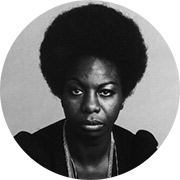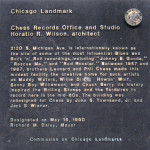If you say Songs about Buildings, the first thing I think of is Talking Heads‘ second album, named More songs about buildings and food. It’s a great LP (produced by Brian Eno), with brilliant tunes (like their cover♾ of Al Green’s classic Take me to the river), but it doesn’t include any song about buildings (nor food, for that matter).
The Rolling Stones: 2120 South Michigan Avenue (1964)
Since they where very young, the Rolling Stones felt they should pay respect to the musicians whose work inspired them (and whose tricks they borrowed). They actually invented the notion of paying dues, inviting bluesmen to perform with them (often re-starting careers, by introducing a whole new generation to older Blues artists), covering their songs, mentioning them in interviews. You could say that this was the bare minimum, considering the amount of borrowing they did. The truth is, not many young 60s musicians thought of what they were doing as culture. You heard a riff, you liked it, you took it – as it’s done in popular music. But then, just as it happens in folklore (in the broad sense of the word), you should acknowledge where a particular sound comes from. The Stones went even further, and recorded a five song EP, Five by five, at 2120 South Michigan Avenue in Chicago, at Chess Records’s recording studios (a place highly fetishized by Blues fans; today the building is home to Willie Dixon’s Blues Heaven Foundation), and naming an instrumental track after its address.
Chess of course being one of the most important Chicago Blues record labels. Its list of recording artists reads like a history of urban Blues. The Stones were certainly trying to capture that sound. I’m not sure they actually made it that time but, over the years, the sound of the band became so good that, since the mid 1970s, most electric bluesmen (including some of the band’s early idols) have been actually striving to get the Stones sound.
2120 South Michigan Avenue belongs to a very early stage of the band’s career. Recorded in 1964, Five by five was released in England as an EP, and repackaged a few months later as their second album for the american market (after the huge success of the first) with the title 12 X 5. Like the previous one, this is mostly an album of covers. This instrumental jam (the longest of the two versions available) is one of the originals: obviously the Glimmer twins were still honing their skills.
buy from amazon • buy from itunes • play on spotify
Nina Simone: House of the rising sun (1967)
 Full disclosure: when I was 10 (in 1969), this is the very first song I learned how to play on the guitar (in A minor, with that bitch F chord so hard to do). It was, of course, the Animals version♾, at the top of both the US and UK charts in the summer of ’64. A few years later I heard the Bob Dylan’s The House of the rising sun☊, included in his 1961 eponymous debut album (entirely made of covers). Then, watching the brilliant Scorsese 2005 documentary No direction home, I found out that Dylan took this song from Dave Van Ronk♾, one of the musicians of the New York folk scene. It turns out that The house of the rising sun, aka Rising sun blues (credited as traditional), has been around forever, and there’s even a 1937 field recording of a lady named Georgia Turner singing it☊.
Full disclosure: when I was 10 (in 1969), this is the very first song I learned how to play on the guitar (in A minor, with that bitch F chord so hard to do). It was, of course, the Animals version♾, at the top of both the US and UK charts in the summer of ’64. A few years later I heard the Bob Dylan’s The House of the rising sun☊, included in his 1961 eponymous debut album (entirely made of covers). Then, watching the brilliant Scorsese 2005 documentary No direction home, I found out that Dylan took this song from Dave Van Ronk♾, one of the musicians of the New York folk scene. It turns out that The house of the rising sun, aka Rising sun blues (credited as traditional), has been around forever, and there’s even a 1937 field recording of a lady named Georgia Turner singing it☊.
But does it talk about an actual place? The question is so good, Wikipedia has separate chapters for answers: Possible real locations and Metaphorical locations. What I know for sure is that you can visit The House of the rising sun Bed & Breakfast, 335 Pelican av, Algiers point, New Orleans Louisiana, and ask them. Or you can visit their website, where they have a very informed page on the origins of the song.
As for this version, included in her 1967 album Nina Sings the Blues, I can only say that it’s my favorite – for two reasons. First because it proves that a good song always works, even if you play it in a radically different way. Second because, at 1’23” into the song, they throw the harmony out, stay on two chords and beat the shit out of ’em, grooving for the remaining two and a half minutes like the world was ending. Plus Nina* gets to improvise some very amazing vocal melodies. Please note: if you add a kick drum, you get House music.
buy from amazon • buy from itunes • play on spotify
* You should see the excellent documentary What happened, miss Simone? on the intense life of this incredible musician and person.
Jay Z feat Alicia Keys – Empire State of Mind (2009)
This song has a building in the title, but then it only mentions it in passing. Still, there are so many actual places named in this song, that you could say that it’s about numerous buildings and places in New York. The truth is, this song is about something else entirely. It’s the post-Obama, self celebration of a wealthy and powerful citizen of the city of cities, singing and acting like he actually owns the place (and he might). The video (directed by the very expert, and aptly named, Hype Williams) works perfectly with the song, suggesting urban aristocracy and elegance. This song has quite a few authors, and a complex copyright history (told in detail on the song’s Wikipedia page) The (merciless, and outstanding) hook is sung by the always lovely Alicia Keys. I have just one thing to say about Alicia Keys: if Bob Dylan mentions you in a song (Thunder on the mountain♾, on his 2006 Modern times album), you must be really cool.
